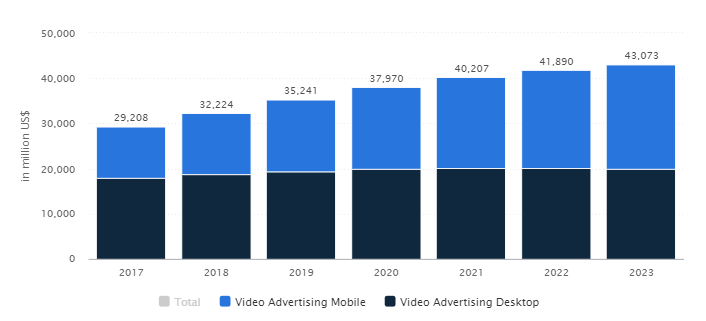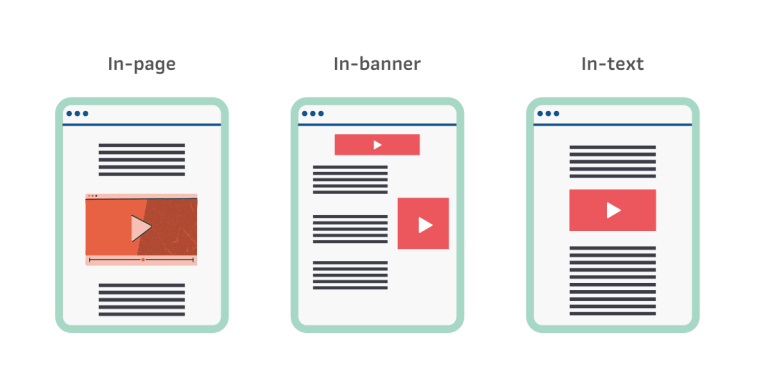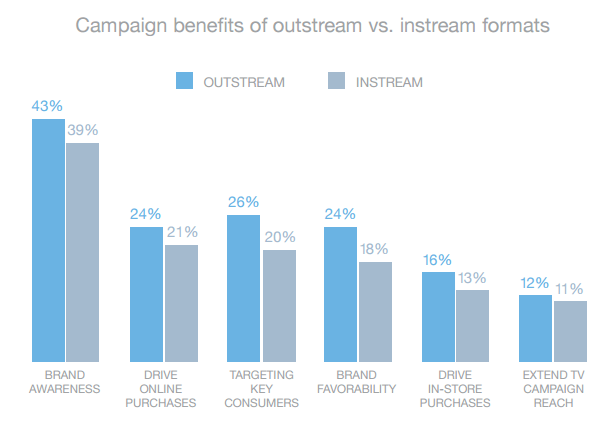Outstream video ads play outside of traditional video players, such as in the middle of an article or on social media feeds. Learn more about its types, benefits, and how to get started.
By 2021, 80% of internet traffic will be represented by video, as predicted by Cisco.
Likewise, ad tech video ad spend is predicted to reach US$37 billion in 2020 and US$43 billion by 2023.
With Google encouraging to use outstream video ads, a boost in outstream video advertising is naturally expected.

But what is outstream video advertising about? How’s it different from in-stream advertising? Let’s learn more about all that here.
What is an Outstream Video Ad?
Outstream video ads are ads that don’t require video players to run on the publisher’s inventory. Etymologically, out-stream means out-side the streaming media/service.
Since there is no need for video players, publishers with editorial content are able to show video ads. The autoplay video ads on the Forbes website is an example of outstream video ads.
Back in time, users only saw video ads with video content. Like YouTube, where you have noticed in-stream video ads (pre-roll, mid-roll, and post-roll) in bulk. For ad tech, it was difficult to utilize video ads on websites because of technical challenges and user experience norms.
The biggest challenge was to show video ads without increasing page load time. Then there were problems like designing an ad unit that shows both video ads and banner ads (as a fallback in case of no video ad bid is received).
But with time and technological advancement, we tackled these challenges and now publishers can show video ads with/without showing video content.
What are The Types of Outstream Video Ads?
These are the three main types of outstream video ads. Your partnered network can offer customized placement like overlay style, expand on user click and more.
| In-page | In-banner | In-text |
| A customized video player is placed on webpage to show only video ads. | Display ad units are customized to show video ads specific to the size of the ad unit. | Video ads are designed to appear after user scroll (> 50%) within the test to offer highest engagement. |

Each of these ad formats has its own unique characteristics and can be effective in different contexts. Let’s take a look.
In-Feed Ads
In-feed ads are ads that appear in a social media feed or on a website’s homepage or article pages. If you’re on social media, you might come across these types of ads while scrolling through Instagram, Facebook, and, more.
Interstitial Ads
Next, an interstitial upstream ad is a common type of out-stream video ad that appears between content or before a user reaches their desired content.
Native Video Ads
These ads blend in with the content of a website or social media feed and play automatically. At first, you may think it’s part of the publishers’ content. But that’s actually an ad perfectly blended with the content.
In fact, according to Outbrain , native advertising is expected to reach $98.59 billion in 2023. Thus, it’s definitely worth trying it with the video format considering how popular and effective it has become.
Banner Ads with Video
These are ads that show up as a banner on a website or within an app, and when clicked, they expand to play a video.
In-Read Ads
In-read ads appear within an article or webpage and play automatically when the user scrolls to the ad’s location.
Autoplay Ads
As the name suggests itself, these ads play automatically on your device when you land on a webpage or open an app.
Click-to-Play Ads
Lastly, click-to-play ads work opposite to autoplay ads. These ads require the user to click on the ad to play the video.
Furthermore, the type of out-stream video ads used depends on the advertiser’s goals and the context in which the ad will be displayed.
Instream vs. Outstream Video Ads
Don’t video ads compliment video content? Placing them with editorial content can be risky for businesses.
You, just like the rest of the publishers, might be having these thoughts. However, Teads data shows out-stream ads to perform better than instream video ads.

Here is a detailed comparison of outstream vs instream video ads:
| Parameters | Outstream | In-stream |
| Video player | Not required | Require video player |
| User control | Ads can be scrolled and skipped | Interrupt the main content |
| Intrusive | Can be muted (recommended) | Sound on |
| Technical requirements | Ad unit size and design can be optimized as per requirements | Strict technical requirements |
Outstream videos are getting better engagement and more conversions. Clearly, advertisers and marketers would want to spend more on outstream video ads.
Is Outstream Video Ads Right for Your Website?
We have established that the outstream video advertising market is hot right now. However, does this ad type right for you?
In 2016, BuzzFeed claimed that they are making 50% of their revenue by video ads and pushing this number to reach 75 in the coming years. In the same way, we are seeing The Washington Post, Forbes, and CBS experimenting with video ads.
Video advertising is working for these big media companies. But should you be investing in it?
Yes, of course.
A compelling case for outstream video ads was also made when Google launched them as an additional service in 2018. This directly indicates that big advertising platforms such as AdWords and others see outstream video ads as a profitable market, likely to expand in the upcoming months.
In short, you—a publisher—should start experimenting with video ads and now is the great time to start.

What are the Benefits of Outstream Ads for Publishers?
Here are some significant benefits of out-stream video ads for publishers:
Video ads without video content
Outstream video ads allowed publishers with no video content to show video and monetize with it. Since video advertising is supposed to be the next big thing in ad technology, all publishers get their chance to experiment with the tech because of out-stream video ads.
No more banner blindness
Banner blindness causes users to ignore ads on a page wasting the advertiser’s campaign money and decreasing the publisher’s viewability score. In such a case, video ads have proven to reduce banner blindness and offer better user engagement. According to Bannerflow data, in-video banner video has improved CTR by 18.4%.
Easy setup
As the demand for video inventory is growing more and more ad agencies are offering simpler solutions to video advertising. For some networks and servers (including Google), video advertising is as easy as placing a code snippet..
Disadvantages of Outstream Video Ads
Outstream video ads has some disadvantages too. Here are some of its disadvantages:
Tricky to monetize for first-timers
Outstream video is a new technology which seems to be working for big publishers. However, if you are starting right now, the results might not be as glamorous as you are expecting.
You would be required to put in extra man-hours to optimize your ad units to work for various video ad placements.
Can be intrusive
If your video ad is intrusive, Chrome will filter it out. Coalition for Better Ads made it clear that video ads with sound on is the most annoying ad type out there. Start by avoiding that.
When it comes to intrusive ads, there is no fixed definition. So it is recommended to stick to industry standards even in the case of video advertising.
Not the right solution for small publishers
Video ad networks have minimum traffic and revenue requirements for publishers in order for them to use video advertising. For small publishers, it can be tough to make the cut. And even if they do, managing the video inventory along with the rest of it brings out the requirement for an ad operation team—which in return increases the cost.
Also Read – 7 Tips To Increase Programmatic Video Ad Revenue
What’s the Right Time to Use Outstream Video Ads
Outsteam video ads make a great option for advertisers who have been previously advertising with video players only. By going beyond video players, advertisers can attract more leads and sales if everything is done right.
Here are some specific situations where out-stream video ads can be particularly effective:
Cost-Effectiveness
Outstream video ads can be a more cost-effective option compared to traditional video ads, as they don’t require specific video players or pre-roll ad slots. So if you’re looking to save some money and want better returns, going with the outsream videos can be worth it.
Limited Video Inventory
Outstream video ads can be a good choice when traditional video ad inventory is limited or not available. This can be the case for publishers or websites that don’t have their own video content or ad slots. So if your desired publishers do not have a video player and you still want to advertise your brands through videos, you can opt for video ads.
High-Impact Moments
Outstream video ads can also be used to target users during high-impact moments, such as when they are actively engaging with content on a website or social media feed. This can help increase engagement and drive conversions.
Brand Awareness
Yes, you have heard it right. Outstream video ads can be a good choice for brand awareness campaigns, as they can be placed on a variety of websites and in social media feeds where they can be seen by a large audience.
How to Get Started?
First, you need to get in touch with a video ad network. Enquire whether your existing partner(s) offers the outstream ad services or not.
If you are using Prebid (or header bidding)
Prebid supports outstream video ads without having to make any major changes. Basically, you will be winning bids via header bidding to show outstream video ads. To get started, publishers need to have at least one adapter with a ‘video’ media type. If this is not the case with you, then get in touch with networks that can get you video header bidding demand (like AdPushup).
If you are using Google Ad Manager
Google Ad Manager allows integration with outstream video ads (including Prebid and/or any other network setup). Outstream video ads are available for open and private auctions, along with preferred and programmatic deals. The available formats are in-article, in-feed, native, rewarded and interstitial for mobile and desktop inventory.
Frequently Asked Questions – Outstream Video Ads
An outstream video ad is a type of video ad that plays outside of a traditional video player, such as in the middle of an article or on a social media feed.
Instream video ads play within a video player, either before (pre-roll), during (mid-roll), or after (post-roll) the video content, while outstream video ads play outside of a video player, within the content of a webpage or social media feed.
Yes, outstream ads can be skippable or non-skippable depending on the settings chosen by the advertiser. Skippable outstream ads allow the viewer to skip the ad after a certain amount of time, while non-skippable outstream ads require the viewer to watch the entire ad.

Deepak has a keen eye for detail and a deep understanding of the ad tech landscape. Whether it’s through in-depth articles, thought-provoking insights, or compelling storytelling, he’s dedicated to helping people navigate the complex world of ad tech with the simplicity of his words.







